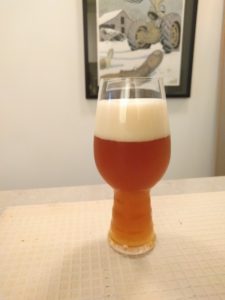Beer Name: Aurora Beer Style: American Strong Ale
OG: 1.081 FG: 1.015 IBU: 80 ABV: 8.7%
Brewed: Feb 5, 2017 Bottled: Feb 21, 2017
Aurora is a beer I’ve been planning for a long time, drawing inspiration from both the American barleywine and the imperial IPA. At one point it was going to be a triple IPA but instead I’ve decided to use Hair of the Dog’s Fred as the basis, but increase the late hopping. This batch is weaker than intended due to an error of using the transferred volume rather than the kettle volume when sorting the grain weights, plus I ended up with more volume than intended. Whoops. As you will see below, no less than twelve different hop varieties are used, besting even Fred’s ten. This will probably be reduced in future batches but this was a freezer-cleaning exercise as well.
Beer Details (2.5 gal batch size): 
8.00 lbs Bohemian Pilsner [86%]
0.80 lbs Flaked rye [8.6%]
0.50 lbs Amber candi sugar [5.4%]
0.25 oz Nugget @ 90m
0.25 oz Centennial @ 45m
0.25 oz Simcoe, 0.25 oz Columbus @ 20m
0.25 oz Mosaic, 0.25 oz Motueka, 0.25 oz Nelson @ 10m
0.5 oz Citra, 0.5 oz Azacca, 0.5 oz Galaxy, 0.25 oz Willamette, 0.25 oz Cascade @ flame-out
WYeast 1728 pitched @ 62F, let rise to 66-68F. Approx 250B cells from previous brew (second gen).
Dry hop: 2 oz Mosaic, 2.5 oz Citra, 1 oz Motueka (4 days)
Brew Day Notes:
Mashed in about 3.7 gallons for 60 minutes @ 153-155 F on the Grainfather. Stirred flaked rye into main mash without cereal mash (thought about that one too late). Mash-out at 170F for 10 minutes, added about 1.6 gallons sparge water at 170F. Drained a little slower than usual but pretty well. Pre-boil gravity 1.055, about 4.2 gallons. Boiled for about 40 minutes before first hop addition. Added hop spider just before adding 20m additions, added remainder of hops to spider. Added sugar at 15 min. Recirculated hot wort from 10 min additions onward, turned on cooling water to counterflow right after adding 0m addition. Chilled through reciruclation to 195F then started transfer to 3.5 gal Brew Bucket. Flow was strong, transfer done in 10 – 15 min. Collected 2.6 or 2.7 gallons and left more than usual behind (0.5 gal?) which is a large part of why the OG was well below target – grain weights were calculated at 2.5 gallons but should have been 3.0 gallons. Collected wort was cold, probably about 62F, no temp probe used. Hit with 30 seconds of pure O2, then added jar of partially warmed yeast.
Activity start around 19-20h, liquid temp 65F. Held at 68F for first 12-14h of vigorous fermentation, then dropped to 64F for 8h (due to drop in ambient overnight) until going back up to 68F.
[Feb 13, 2017] – Week in primary, down to 1.016. Strong bubblegum aroma, pretty clean flavours already. Bitterness is assertive but balanced.
[Feb 18, 2017] – Dry hopped with 2 oz Mosaic, 2.5 oz Citra, 1 oz Motueka. Went with a massive dry hop due to inventory.
[Feb 21, 2017] – Bottled with 1.3 oz of dextrose. Only got 1.75 gals out of the fermentor before I started pulling hop sludge. Got about 2-3 seconds of sludge running into the bottling bucket before I caught it, unfortunately. Let it settle for a bit but the hop sludge was mixed in well / sitting on top too. Ah well. Smell was amazing, lots of ripe fruit and bubble gum.
Tasting Notes
[Mar 3, 2017] – Still a bit before the 2-week rule but it’s perfectly carbed. And exceeding expectation. HUGELY dank both on aroma and flavour. Very full body from the flaked rye, presumably, and nice amount of residual sweetness. Massive hop character; my decision to up the whirlpool and dry hop additions most certainly did result in an imperial IPA with almost no relation to the American barleywine it was supposed to also emulate.
[Apr 14, 2017] – Well the hop character is starting to fade now, but it’s still plenty hoppy. Body is nice and rich without being too malty or sweet, hop character is quite dank still but complex without being too muddled. This will be a freezer-cleaner beer I do again.
[June 9, 2017] – Last bottle. The carbonation increased over time to the point it diminished the body and caused some gushing. Likely this was due to slow further attenuation as opposed to an infection. Also the hop matter which was transferred to bottles was a little excessive, and resulted in some grassy flavours in the aged beer. However, despite this the malt character proved to be quite pleasant and increasingly so as the beer aged. Another batch will be brewed in the future with less finishing and dry hopping to reach a more balanced character, and better process to deal with the hops. Also, some conditioning time in secondary may be worthwhile on a beer this strong.
